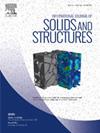具有广义轮廓的基于Wohlhart 6R链接的非对称可展开结构
IF 3.8
3区 工程技术
Q1 MECHANICS
International Journal of Solids and Structures
Pub Date : 2025-04-24
DOI:10.1016/j.ijsolstr.2025.113388
引用次数: 0
摘要
基于刚性机构的可展开结构是一种非常规结构,可以实现从紧凑折叠状态到完全展开表面的转换。这些机制的移动性非常低,甚至只有单一的移动性,这使得部署过程更加简单。这种结构在建筑、航空航天工程和机器人等各个领域都有重要的应用。目前,这些结构的组成机制通常具有对称的几何条件,从而产生对称的轮廓。然而,这种对称性要求使得它在需要更广义形状的特定场景中不太理想。为了填补这一空白,本文引入了基于Wohlhart 6R连杆的两种新型非对称可展开结构,其轮廓可以是任意三角形。第一种结构由连杆构成,能够在两种平面状态之间转换。第二个是一个改进版本,它将厚度均匀的刚性面板作为连接,可以从一个长三角棱镜折叠成一个短三角棱镜。详细分析了它们的运动特性,并通过物理样机进行了验证。我们还确定了可行的方法,将这两种结构镶嵌到大规模应用的网络中。这项工作为构建具有广义轮廓的非对称可展开结构奠定了关键的一步。本文章由计算机程序翻译,如有差异,请以英文原文为准。
Wohlhart 6R linkage-based asymmetric deployable structures with generalised contours
Deployable structures based on rigid mechanisms are unconventional structures that can achieve transformations from compact folded states to fully deployed surfaces. The mechanisms are of very low or even single mobility, making the deployment process simpler. Such structures have found significant applications across various fields such as architecture, aerospace engineering, and robotics. Currently, the constituent mechanisms of these structures often come with symmetric geometric conditions, thereby yielding symmetric contours. However, this symmetry requirement makes it less desirable for specific scenarios where more generalised shapes are required. To fill the gap, this paper introduces two novel asymmetric deployable structures whose outlines can be arbitrary triangles based on the Wohlhart 6R linkage. The first structure is made from rod links, capable of transforming between two plane-like states. The second one is a modified version that incorporates rigid panels of uniform thickness as links, which can be folded from a long triangular prism to a shorter one. Their kinematic behaviours are analyzed in detail and validated by physical prototypes. We have also identified viable approaches to tessellating both structures into networks for large-scale applications. This work lays a crucial step towards the construction of asymmetric deployable structures with generalised contours.
求助全文
通过发布文献求助,成功后即可免费获取论文全文。
去求助
来源期刊
CiteScore
6.70
自引率
8.30%
发文量
405
审稿时长
70 days
期刊介绍:
The International Journal of Solids and Structures has as its objective the publication and dissemination of original research in Mechanics of Solids and Structures as a field of Applied Science and Engineering. It fosters thus the exchange of ideas among workers in different parts of the world and also among workers who emphasize different aspects of the foundations and applications of the field.
Standing as it does at the cross-roads of Materials Science, Life Sciences, Mathematics, Physics and Engineering Design, the Mechanics of Solids and Structures is experiencing considerable growth as a result of recent technological advances. The Journal, by providing an international medium of communication, is encouraging this growth and is encompassing all aspects of the field from the more classical problems of structural analysis to mechanics of solids continually interacting with other media and including fracture, flow, wave propagation, heat transfer, thermal effects in solids, optimum design methods, model analysis, structural topology and numerical techniques. Interest extends to both inorganic and organic solids and structures.

 求助内容:
求助内容: 应助结果提醒方式:
应助结果提醒方式:


